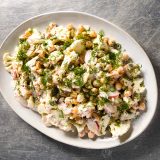Cortney Burns’ Chicago childhood was flavored much like that of her Eastern European grandparents—that is, sour, briny and fermented. “My grandmother would have fermented beets in a crock on our countertop, and sour pickles were everywhere,” says the chef and cookbook author.
Such was the comfort she found in those flavors, it’s no surprise Burns leaned heavily on them for the menu at San Francisco’s storied Bar Tartine, where Burns ran the kitchen along with Nicolaus Balla. “There’s so much crossover between strong, funky flavors and fresh, crisp, creamy flavors, the food that felt like home to us,” she says.
Bar Tartine’s salad featuring raw cauliflower, chickpeas, radishes and button mushrooms is a perfect example. Combined with dill, parsley and tarragon, the salad is tossed with a zingy dressing of lemon juice, red wine vinegar and yogurt. And those last three ingredients are key.
The yogurt, vinegar and lemon juice add pops of bright, sour flavors that bring depth and complexity to the salad. Sour isn’t just a flavor—it also can be a texture enhancer. Tartness is an indication of acidity, and sufficiently acidic ingredients can gently soften raw vegetables by weakening the tough cell walls that give them their crunch.
An ingredient’s acidity is measured in pH: The lower the pH number, the stronger the acid. The dressing in Bar Tartine’s salad relies on lactic acid from the yogurt (which has a pH of 4.3 to 4.4), acetic acid from the red wine vinegar (roughly pH 3.5) and citric acid from the lemon juice (pH 2 to 3). The combination of these acidic ingredients is enough to soften the vegetables.
Another factor that determines the effectiveness of the acids is the vegetables themselves—or, rather, how they’re prepared: The more thinly sliced they are, the more they soften thanks to the greater surface area exposed to the dressing.
Bathed in the acidic dressing, the starchiness of the chickpeas becomes silkier and the raw vegetables more toothsome as they marinate. “It layers in a lusciousness that we wouldn’t otherwise be able to capture,” says Burns.
She urges home cooks to see her salad as more of a template than a recipe, one that lends itself to experimenting with other vegetables, such as fava beans, asparagus, snap peas, baby carrots or fennel. “You don’t like one spice? Use a different one. If you don’t like one herb, change it up,” she says. “I’m really encouraging people to play.”
So we did. We loved the taste of the cool, creamy dressing, as well as the way it tenderized raw vegetables while still preserving their crunch. We focused our herbs on the dill, the flavor of which paired especially well with the yogurt. And we found that the combination of lemon juice and yogurt was sufficiently acidic to wilt the thinly sliced vegetables, no vinegar needed. With these sour notes, we found sweet success.
“I’m really encouraging people to play.”




